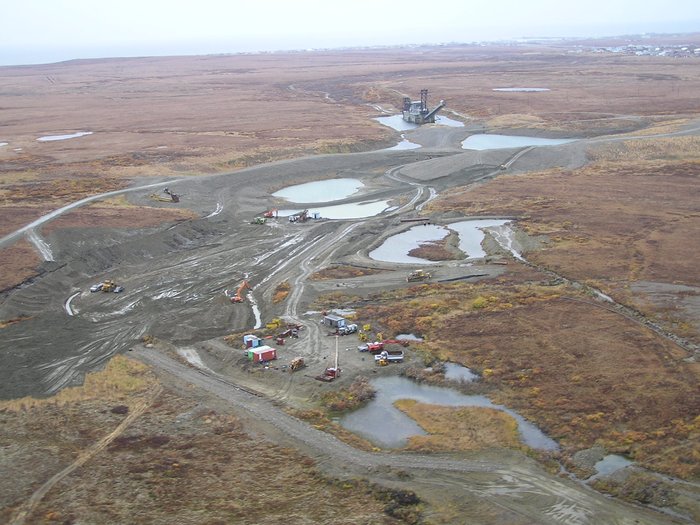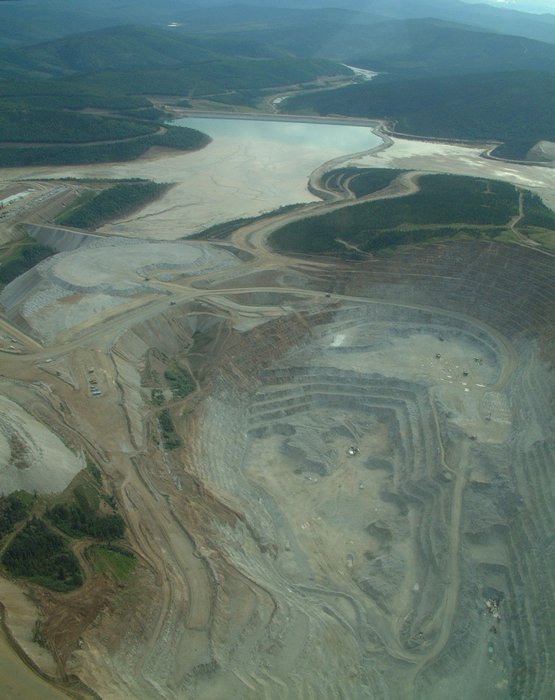
_
There are strange things done in the midnight sun
By the men who moil for gold…
_
Summary
Historically, the majority of gold was mined from “placer deposits”, where gold has settled out of an existing or ancient waterway downstream of where nuggets had eroded out of rock outcrops. Some early miners also used an early form of hardrock mining, digging solid veins of gold out of rock, where mineralized water had deposited it over thousands of years.
Today, gold is extracted in hardrock mines that directly mine the source rock, or “lode” of gold, where it was originally deposited by geochemical processes. Most ore accessed this way today contains only microscopic grains of gold, and it takes tons of rock to produce ounces of gold. Hardrock mines can be either underground mines or strip mines, and are usually more environmentally destructive than placer mining.

Placer Mining
The stereotypical grizzled gold-rush prospector panning for gold was searching for “placer gold”, or gold deposited in a waterway. Placer mining takes a variety of forms, including panning, “sluice-boxing”, hydraulic mining, and dredging. All of these techniques use gravity and water to separate the dense gold from the lighter sand and gravel. Some modern commercial placer operations are quite large and utilize heavy equipment and river diversions.
Placer mining targets “native” gold that isn’t chemically bound up within the rock itself. The sources of all placer gold are “lodes”, or veins of gold naturally formed within the rock. Ongoing weathering and erosion of rock outcrops continuously exposes new fragments of gold that wash downstream. Because gold is far denser than most rock (19.3 g/cc as opposed to about 2.7 g/cc) it settles into little pockets between large rocks or into bedrock fissures. Gold accumulates in such places while other rock and sediment is washed further downstream.

Hardrock (Lode) Mining
The vast majority of current gold production comes from commercial hardrock mining operations. In these mines, the gold is extracted from the rock where it was originally deposited.
Some hardrock mines are underground mines. A tunnel is drilled or blasted to the source of the ore, which is transported out for processing often by truck or rail. A variety of specific techniques can be used for mining the ore, depending on the geology of the area - such as block caving, which allows massive strip-mine scale underground excavation, or the more steretypical cut-and-fill and drift-and-fill techniques, where miners dig our out in long horizontal tunnels.
Other hardrock mines are large strip mines that remove the surface dirt and rock and then extract the ore from the resulting open pit. Removal of ore is often accomplished explosives, enormous power shovels, and massive trucks, some capable of carrying 500 tons of rock in one load.
In both kinds of hardrock mining, the ore is then processed in some manner to remove the gold. Usually this entails crushing the rock into powder and using some combination of gravity, centrifugation, and “froth flotation” to perform an initial separation of gold from rock. In many cases this is followed by some form of cyanide treatment to precipitate out the remaining gold. The remaining ore mud waste is known as “tailings”, the disposal of which is one of the largest challenges facing a hardrock mine.
Reconsidering the Value of Gold
READ ESSAY
… Gold is both highly valuable, and relatively useless. The vast majority of gold mined throughout history is now jewelry, or stored in vaults as an investment…
… This means that governments are in effect lowering the cost of environmentally destructive mining, contributing to demand by hoarding large reserves, and then directly paying for the costs of mine cleanup. All this in return for no material benefit to taxpayers…
Impacts
Because placer mining doesn’t crush rock and doesn’t usually use chemicals to extract gold, the environmental impacts are generally less than those of hardrock mining. The primary impacts of placer mining are habitat destruction and sediment release. Habitat destruction occurs as a result of river diversions, and the disruption of riverbanks and river bottoms. These activities also release large amounts of silt and sediment into downstream waterways, which can severely impact water quality. Modern commercial operations tend to use settling ponds to prevent this discharge.
Hardrock mines have a much larger environmental footprint that placer mining, by virtue of their size, the chemistry of the ore deposits, the generation of extremely large volumes of hazardous waste material, and the use of toxic chemicals. Modern commercial hardrock mines are massive operations, in some cases displacing and processing over 200,000 tons of gold-bearing ore per day. In addition to the direct ecological disruption of mining on this scale, much of the gold mined this way is found in sulfur-bearing rocks. These rocks, when disrupted by mining, can produce acid mine drainage, a problem that often needs active treatment forever. In addition, many small mines use mercury for the separation of gold, while large mines instead use cyanide. Both chemicals are very toxic, and mercury is persistent in the marine food chain.
Gold mining in Alaska
Gold mining has a long history in Alaska, beginning with the Klondike Gold Rush at the end of the 1800s. Even today there exist a variety of placer mining operations ranging from large commercial placer mines to stream panning by tourists. The 150 or so official placer mines in 2009 produced 55,000 ounces of gold while employing around 225 people. “Recreational” mining (non-commercial operations, usually by individuals) produced an additional 286 ounces.
Alaska’s hardrock gold/silver mines (primarily Greens Creek, Fort Knox, and Pogo) employed almost 900 people that same year, and produced over 720,000 ounces of gold.
Further Reading
Created: Jan. 19, 2018